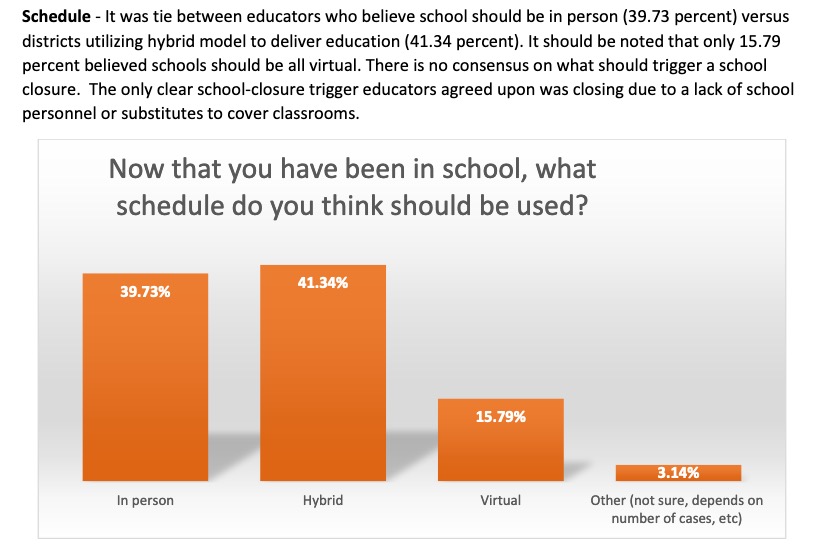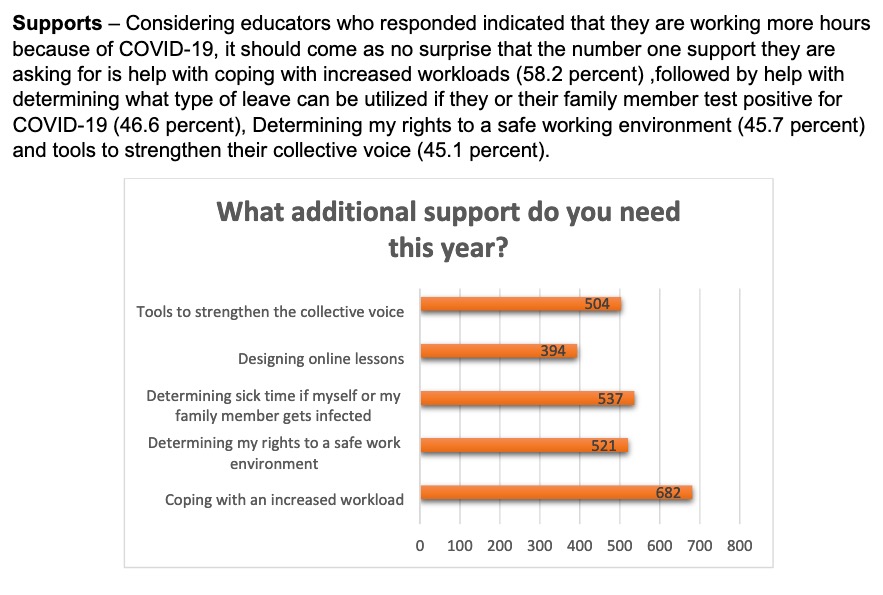One of the most serious policy debates amidst the coronavirus pandemic is whether the public health gains of keeping kids home from school are outweighed by the perceived losses in educational outcomes and socialization caused by learning online.
While teachers recognize that planning and delivering effective online lessons requires more work than executing the same lessons face to face, a new survey from the South Dakota Education Association indicates that, now that we’re back in school and wrestling with the challenges of masks, social distancing, and rolling quarantines, a majority of teachers (also known as the best experts we have on educating our kids) think the traditional classroom model isn’t the best option amidst a pandemic:

In my proposals to use our coronavirus dollars to help schools shift to safer and more robust hybrid teaching models, I’ve emphasized the need to hire more educational technologists and curriculum designers to help teachers design online lessons. But this survey suggests that our teachers see a greater need for general help keeping up with their increased pandemic workload. Of the 1,178 teachers who responded to the survey, only a third—394—said they need more help in designing online lessons. Far more teachers—54% of whom report working 50+ hours a week—say they need more voice in how their schools are dealing with the pandemic, more protection of their workplace rights, and, most of all, more hands and hearts helping to teach and protect our kids:

We need to listen to our teachers. They are telling us that gathering our kids in traditional classrooms on traditional schedules is not as essential some leaders insist. They are telling us we need to think differently, support online education, and support them with more resources—i.e., more money and more people—to do this essential work.
From SDSMT President Jim Rankin this week:
“At last week’s Board of Regents (BOR) meeting, the face covering level was discussed. We will stay at level 3 for now. I also think we need to see if colder weather, which will cause people to spend more time indoors, has an impact on our positive cases.
There was more discussion at the BOR meeting about increasing classroom capacity so that more students can attend class in person. Our current capacities are in the 25-35% range and we are looking to increase classroom utilization as a next step so more classes can be offered as face-to-face. We are also looking at classroom assignments for spring semester, so that more students can be in class. The number of fully online courses is also being reviewed with a goal of reducing that number, if possible.”
Unclear why, with the expectation of cold weather enhancing COVID risk, increased classroom capacity and a reduction of online courses is being considered, other than to try to cover all bases.
http://campaign.sdsmt.edu/president/message/Weekly-Address/10-14-2020/10-14-2020-Weekly-Address.htm
One of the best things that can happen for education in the USA is rebuilding respect for teachers. I’d like to see a chunk of tax $ from the federal level, state level and local level designated to teacher pay and untouchable for anything else. Not optional, it must be raised and paid without fail. Include penalties if it’s not paid. (Or something like that.)
All full time teachers should be paid 6 figures minimum. One of the most effective ways to increase respect is via pay.
(Think of what that would do for the local tax base!)
One of the biggest things that happened in the teaching of writing was word processing. It was akin to the introduction of pencils with erasers. Software companies designed some very useful programs that put students on a network with their classmates. Class discussions on assigned readings and on the student papers were in text form, thoughtful, and as they formed a record of discussion, made it possible to evaluate and provide substantial credit for participation. I recall that at the beginning of a semester, the transcripts of discussion would be 8-10 pages for a session, but toward the end of the semester, they would be 60-70 pages. And because the students were applying their writing skills, their fluency and focus showed marked development.
But as computers became an integral part of instruction, they changed the role of the instructors. But they also increased the workload as there was much more material to evaluate. In traditional writing classes, many students saw the professor as their audience.
With computers, they knew that their peers AND the professor were the audience. This required the development of new strategies to deal with the concerns students have regarding who they are performing for.
But as computers were incorporated into the process, there was no distinction made between in-person and virtual instruction. And no one thought they were hybridizing. It was all part of the process of learning.
That’s a good point, Dr. Newquist.
In the summer of 1978 I wrote a paper on trench warfare in WW I for a prof at SDSU. He was in the history department and extremely helpful. In fact, he and my Grandmother discussed several historical issues because she had a great deal of knowledge. My grandfather had been deployment to Europe as a machine gunner.
Anyway, it was fascinating, enlightening and I earned an A on the paper. I’ve forgotten the prof’s name, probably because we never met. It was all carried out via telephone and I dropped items off at his office on campus because I lived near Brookings at that time.
I guess that was a virtual independent individual project.
The worst thing ever to happen to public education was wingnut pols.
The covid bug infestations is indeed a good time for some of the teachers to step up, work harder, and shine their way up the SILT. Those who work harder can get paid more with all the covid money the schools are getting. Those who laze about at home leaving the kids to be educated by Big Bird and Oscar the Grouchy should move down the SILT and get paid less.
Grudz-is SILT what you commonly throw into these discussions??! (Silt=mud @ the bottom of a SD bass pond).
Mr. Jake, apologies for using an acronym common to those of us interested in paying good teachers more. SILT stands for the documented “Seven Indisputable Levels of Teachers”
grudznick, your SILT is not common among educators; it is not common among policy makers; is is nothing more than your silly, thinly veiled contempt for public workers in the guise of “higher standards.”
All teachers in the great state of SD would knock the top off your silly index; prove me wrong.
Mr. o, it is a fact that in any large group there is an Average. So we know we have Average Teachers.
—
Average Teachers
—
And, it is a fact that if we have an average, and all cannot be the same, then we have this
…
Above Average Teachers
Average Teachers
Below Average Teachers
—
And, it is further a fact, if we take Mr. H’s word for it, that we have both Very Bad teachers who have done naughty things with students and gone to jail, as he has blogged. And, he has also blogged about Very Very Good Teachers and also Excellent Teachers, when he has written about some teachers that have gone above the usual duties, and of course about the teachers who have won the Teacher of the Year award. So now we have
Excellent Teachers
Very Very Good Teachers
…
Above Average Teachers
Average Teachers
Below Average Teachers
Very Bad Teachers
And then, we can infer from Mr. H saying there are Very Very Good Teachers that there must be Very Good or at least Good Teachers as well. I give them the benefit of the doubt.
That leaves us with:
Excellent Teachers
Very Very Good Teachers
Very Good Teachers
Above Average Teachers
Average Teachers
Below Average Teachers
Very Bad Teachers
And, there you have it, Viola! The SILT!
Now, I want you to know, as I’m sure you do as the smart fellow you are, we could have many more levels inserted in between the Very Bad Teachers and the Excellent Teachers if we wanted to. Also, note that like the A, B, C, D and F grading scale, we have a missing hole in the scale, where there are no plain “Bad Teachers”. That’s intentional, so there are more levels above Average than there are below, so more teachers can feel good about themselves. It’s like a participation award.
The SILT are indeed a fact. Proven for you here, based on math and Mr. H’s own bloggings.
My dear Mr. Grudznic, your linguistic trickery does not fool me. Although any group must have a mean, that in no way indicates that mean is “average.” There is an mean height of NBA players; however, that height is not average. SD teachers are the NBA players of education — a truly above average lot.
Furthermore, I IN NO WAY believe you could distinguish teachers performing at any of the seven levels you indicate. Your Orwelean double-speak holds no sway here.
“The NBA players of education.’
That’s truly a quote worth repeating by the union reps directly to the legislatures, and often. I love it. Thank you for make an old man smile.